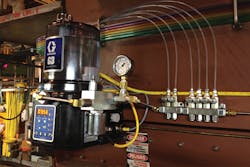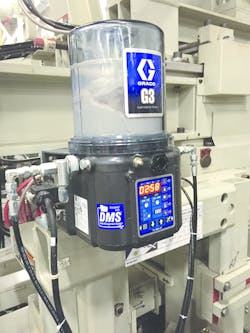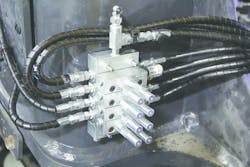Maximize reliability with automatic lubrication systems
Reliability is an increasingly common focus for maintenance professionals. From steel to food and beverage, every industry has a strong desire to get the most out of every resource and every piece of equipment. One of the most overlooked opportunities to improve on an existing program is in process pumps, a lesser asset with a big impact on overall process reliability. Many things should be considered when it comes to pump reliability, from the design of the system to the selection and operation of the equipment, to a proper maintenance program.
A proper maintenance program is essential to achieving the longest possible life from a pump, and proper lubrication is a key element of that program. A well-planned lubrication program can extend the life of pump bearings out to five to seven years, depending on the application. An increasingly popular component of such a plan is an automatic (centralized) lubrication system.
Standard practice in industry is to lubricate bearings with a large amount of grease or oil (often unmeasured) on a daily, weekly or monthly schedule. This means bearings start out being overlubricated and move quickly to being underlubricated, while spending a minimum amount of time in the "sweet spot." The excessive heat, increased wear, higher energy consumption and wasted lubricant mean much higher operating costs and decreased pump reliability. Automatic lubrication systems take a predictive maintenance (PM) plan to the next level by applying precise amounts of lubrication with a specific frequency to multiple points simultaneously. This timed, precision application of the lubricant keeps the bearings in a pump (and motor if desired) in a constant state of optimal lubrication. That means longer bearing life, less downtime, more efficient energy use and fewer man hours spent repairing component failures.
Industrial lubrication systems are designed to specifically meet the individual needs of the application and can often include multiple assets in close proximity. To accomplish this, a few items need to be taken into consideration before equipment selection can begin.
Single-stroke pneumatic pumps are cost-effective to operate for small, single-line systems.
Lubricant selection
Selecting the proper lubricant is the first step to increasing reliability. Whether it is applied manually or automatically, the type of lubricant selected for a process pump will have a big impact on the success of the lubrication plan. If running high rpm, such as in many centrifugal pump applications, look for a less-viscous lubricant that can flow freely into the fast-moving components of the bearing. For a low-rpm application, which will involve mostly positive displacement pumps, a higher-viscosity lubricant will aid in keeping a lubricating film across all surfaces. Considerations for temperature and contamination should also be made.
Volume requirement
The volume of lubricant applied to a bearing is equally as important as choosing the proper lubricant. Too much will cause excess heat, while too little can lead to excessive wear. The problem with manual lubrication is that PM cycles are started with too much, and ended with too little. This is where an automatic lubrication system makes the difference. By calculating the precise amount of lubricant that is needed, one can increase the frequency of lubrication events while decreasing the volume per event. To find this critical value, use the following formula:
V= [D2 x R x 0.001 x SF] in3/hour
V=Volume; D=Diameter; R=Radius; SF=Service Factor
Proportional relationship
Accurately distributing the correct amount of lubricant to multiple points with varying volume requirements necessitates the use of the proportional relationship between the points. Knowing the ratio between the smallest volume requirement and the largest volume requirement will help to decide between a series progressive system and a single-line parallel system. Although both systems are designed to achieve the same results, they each have their own benefits and drawbacks. Careful selection of the proper equipment will prevent costly failures and changes to the system in the future.
Some pumps, such as this example, have the capacity to operate two to three separate systems, adding to the versatility of this equipment
Single-line parallel system
The single-line lubrication system is a straightforward system in which a pump pressurizes a single line that contains one or more injectors, causing those injectors to release a measured amount of lubricant into the intended lubrication points. Injectors function in parallel and do not rely on any preceding injectors to operate. Once they have dispensed, they remain locked out until the pump receives the signal to vent the line and relieve pressure, allowing the injectors to reset and wait for the next event.
Injector systems are easy to install, easy to maintain and easy to understand. These systems are expandable in the field and have the capability to deliver lubrication through long runs. With visual performance indication on every injector, lube technicians can quickly and accurately determine which lubrication points are not receiving lubrication while the rest of the system remains functional. As an added fail-safe, feedback from the pressure switch will not only tell the pump when to vent the pressure, but also send a signal to an optional alarm if the system fails to pressurize in the allotted time.
Series progressive system
Series progressive lubrication systems offer a larger selection of metering and feedback options than the single-line systems; however, they also come with increased complexity in design and function. With a recommended maximum of 484 lubrication points, these systems can be incredibly intricate and require a thoughtful design and planning process. In turn, these systems are typically more difficult to understand and require an experienced technician for installation.
Unlike the single-line system, the progressive lubrication system does not require the use of injectors. Instead, the pump will continue to move lubricant through a series of progressive divider valves of varying outputs until it receives the signal to stop. This signal is generally sent by means of a switch that counts the completed cycles made by the primary block assembly. If the predetermined number of cycles are not completed in the allotted time, the system can set an optional alarm.
Several different families of divider valve are available, each with its own output range and accessory options. From controlled inlet valve options to a wide array of performance indicators, the multitude of configurations for this type of system is astounding.
The performance indicators on this series progressive divider valve will alert employees to a failure in the system. When feedback options are utilized, the pump control may also sound an alarm.
Pump selection
Manual, pneumatic, electric, mechanical, etc. — these are all options when selecting a lubrication system pump. Single-stroke pneumatic pumps work well for small single-line systems, while reciprocating pumps are ideal for larger single-line and progressive systems. Pump output needs to be large enough to deliver the necessary amount to the points within the set amount of time. Consideration must be made for friction loss, compressibility of the lubricant and charge volume of injectors.
Reservoir size must also be looked at closely. A small reservoir with high demand will require near-constant
attention, while an oversized reservoir leaves the potential for separation and ultimately, undue wear on the bearings. An appropriately sized reservoir will accommodate approximately 30 days of normal operation. This will allow for less frequent maintenance and ensure periodic inspections.
When the appropriate considerations are made in the design process, an automatic lubrication system can have a positive influence on the overall reliability of the equipment involved. Longer-lasting bearings in all of a facility’s pumps can equal a substantial cost savings when the reduction in downtime and man-hours as well as a reduction in wasted lubricant are calculated.
Scott Edmonds is an application specialist for Motion Industries who focuses on automatic lubrication systems design and process pump theory. Throughout his 15-year history in industrial supply, Edmonds has worked in the application of process pumps, chemical testing and compatibility. For more information, visit motionindustries.com and Mi Process Pumps Specialist. Watch MiHow2 lubrication videos at bit.ly/2oc7get for some informative demonstrations.




